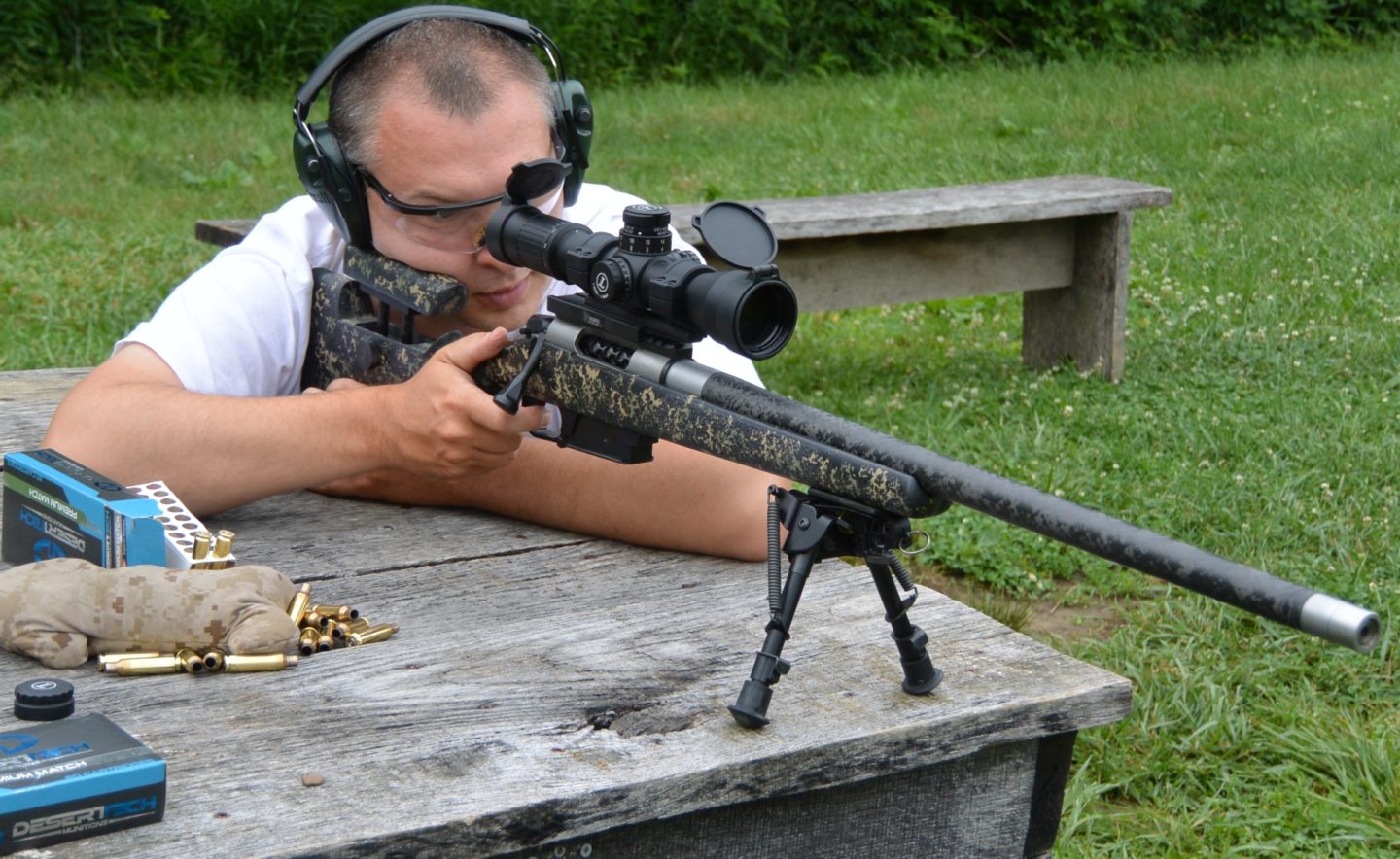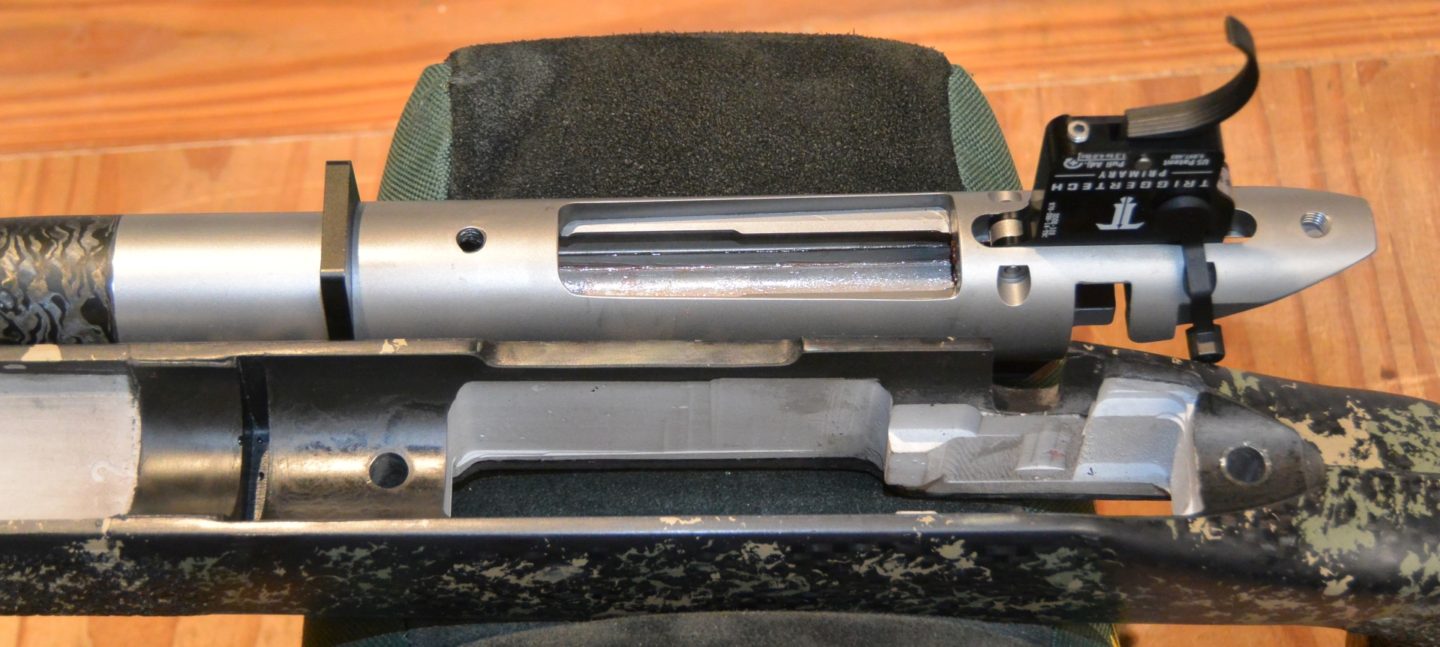Mesa Precision Arms Crux Ti in McMillan Adjustable Game Warden Edge Carbon Stock

When doing a review of a custom rifle, you are, to some extent, necessarily also reviewing a variety of components from third party suppliers that become part of the rifle. In the process of reviewing the Mesa Precision Arms Crux rifle, I found myself about 3/4ths of the way to a review of the stock. Since only a few review products have arrived so far this year, I figured I would finish the thought and expand the text into a full review of the McMillan stock.
Background on McMillan
McMillan is one of the oldest players in the rifle stock market. They have been making composite stocks since the early 1970s. Since then they have grown to become the largest composite stock maker in theo world by both volume and number of models. Probably most iconic is the M40A1 stock they developed for the Marine Corps in 1975, though the A5, which was developed in 2002 and released in 2003 with a great deal of input from the folks right here at SnipersHide, is currently the most popular model. McMillan is also well represented in the shooting sports and has a long history of being adopted as an OEM for rifle makers’ premium models. There are even a few cases where rifle makers intended to use a cheap plastic stock originally but did not make contract accuracy specs with the plastic and ended up using a McMillan to improve the accuracy and make spec.

How composite stocks work and are made
The first order of business when discussing what a composite stock is and why it is typically the best choice for a custom hunting rifle is to talk about what it is a composite of and how it is put together. A McMillan Edge Carbon composite stock consists of a molded outer shell made up of epoxy impregnated carbon fiber fabric hand laid up in a mold and then later, after curing, filled with a lighter density fill material. The hand laying up is a process very reminiscent of paper maché: with woven carbon sheets in place of the newspaper, epoxy resin for the glue, and with the mold on the outside of the object created instead of on the inside. Just like with a paper maché piñata, you stuff the shell that you have created with the hand layup. You just use a lightweight and harmonically dampening fill material, instead of candy. A couple of years ago, McMillan put together an excellent video showing each of these steps on one of its fiberglass models.
The composite stock produced in this manner has the strongest stiffest material on the outside and a lighter fill inside. This works sort of like an I-beam or bird bone: minimizing the material and weight in less structurally critical areas and maximizing it where it matters most. Furthermore, the materials involved are very temperature stable and harmonically dampening. Composite stocks are therefore strong, stiff, light, temperature stable, and harmonically dampening. In fact, they lead all technologies in most of these areas. For these reasons, composite stocks have dominated the competitive shooting sports for 40 years. The only downside is that, with 8+ man hours in making each one, they are not cheap. This labor intensity does have the upside of resulting in a highly customizable product since variations such as more flush cups, different color, different LOP, or different recoil pad do not cause much disruption in an already very hands-on manufacturing process.
Composite stocks can also be some of the best looking stocks and can be finished in a variety of ways all the way up to the automotive airbrush painting common in benchrest and f-class competition rifles. These can be works of art on par with custom choppers. Another attractive finish that is a bit less costly is the exposed carbon look on the stock in this review. This look is well suited for a field rifle and can be augmented, as in this example, with a variety of different camo sponge paint accents. The Edge Carbon Game Warden in this review is the first carbon composite McMillan that I have had and I was quite taken with the appearance of the sponge painted visible carbon, especially in conjunction with the carbon Proof barrel. In both cases, the carbon has the effect of adding depth to the appearance as well as reflecting light differently at different angles to add movement. The appearance is one of luxury, quality, and beauty, and will not be mistaken for cheap plastic even at a casual glance. This look is a great compliment to the superior functional aspects of the carbon composite stock.
The Game Warden and A10 Models
The particular model of stock that I chose for the Mesa Precision Arms Crux Ti build is the adjustable Game Warden. This is one of McMillan’s newer models and was based on their popular Game Scout stock with the fore end enlarged to accommodate larger profiled barrels. It offers a very lightweight option for an adjustable cheek piece hunting stock (mine weighs in at just 2.56 lbs bedded) that also accommodates the larger diameter Proof barrel that I used. This is not a very common combination of capabilities and it is what I needed as I have high cheek bones and very low tolerance for poor fit of the rifle to the shooter. The bit of three position shooting I have done has given me a great appreciation for the importance of fit to accuracy. I expect that this model will prove popular for McMillan as the advent of Proof carbon barrels should provide a robust demand for a traditionally styled, lightweight, hunting stock that can accommodate varmint contour barrel thickness.

Another new model I expect to have broad appeal is the A10 released at SHOT show this year. I actually expect the A10 to overtake the A5 in pretty short order and become the most popular model. Though similar in appearance to the A5, the A10 has a squarer, slimmer, and, it appears to me, lower forearm to better fit competition accessories such as barricade stops. Most importantly, the grip section has been changed to substantially decrease the reach to the trigger. While this is advertised as friendly to shooters of smaller stature, I would argue most shooters will find themselves in that camp. The A5’s trigger reach was best suited to NFL quarterbacks and NBA centers. The reach on the A10 will fit most shooters better. In addition to a shorter trigger reach, the A10 also allows for a shorter length of pull. With spacer system it can be adjusted between 12″ and 13.5″. This shorter LOP is becoming more popular as shooters have adopted squarer stances behind the rifle for recoil management. Weights on the A10 start at 3lbs.
Limitations of, and alternatives to, composite stock systems
While Composite stocks excel in comfort, harmonics, recoil management, strength, temperature stability, and weight, they have lately seen their market share eroded by the rise of chassis systems and stocks that combine elements of a chassis system with molded plastic parts. The first appeal of chassis systems is that they are essentially designed to be used without bedding. This can be done with a composite stock just as a chassis system can be bedded, but neither of these situations are what I would recommend. Composite stocks really shine when bedded and I don’t think chassis systems really get much out of it. Many people are either unwilling to spend the hours it takes to bed a stock or are simply afraid to do it. For some reason, they find the prospect of epoxying their beloved rifle into a stock with the intention of it not becoming forever glued in place daunting.

The next advantage of Chassis systems is that it is very easy to add a lot of adjustability and accessory attachments points to them. Chassis systems have been the norm in 3- position shooting for years because of this. When the whole of your stock is basically carved out of an aluminum block, it is pretty easy to just machine in rails, QD points, and adjustment mechanism attachment points. For this reason, most chassis systems in a market position to compete with composite stocks are significantly more adjustable.
Lastly, chassis systems, especially those chassis systems that combine a partial machined chassis section with injection molded plastic parts, can provide a lot of performance at a price much lower than a composite stock. This did not used to be the case. Stocks cheaper than composites used to be either squishy Tupperware-like affairs or traditional wood. Now some are pretty serviceable, if still very plastic looking and feeling.
Conclusion
Part of the reason I rolled off this McMillan piece into a separate article is that it seems like lately I have encountered a lot of thinking that chassis systems are some sort of next step in the evolution of rifles and composite stocks are passé. As is evident from my discussion above, I disagree with this. Which stock technology is best for a particular shooter and application is much more nuanced. Carbon composites, such as the McMillan adjustable Game Warden here examined, are superior in virtually every way for a lightweight hunting rig. However, for a competition tactical rifle, where adjustability matters more and recoil absorption and weight matter less, the selection is much more complicated. This is reflected in the wide variety of different rifle stock technologies used by competitive PRS and NRL shooters. If that is the sort of direction you are looking to, I encourage you to show up at a match and ask some folks to sit behind some rifles. At the end of the day, the stock is an interface between the body and the rifle and there is only so much a bunch of words in a review can help with this. Should you have questions about the virtually endless product offerings at McMillan or about the process of ordering a composite stock, I would encourage you to call them. Composite stocks are by their nature custom affairs and ordering one is more like having a suit tailored than buying off the rack. I found the folks at McMillan helpful and knowledgeable both during this build process and in the past for other projects before I was an author on SnipersHide and was instead a less than ideal potential customer trying to jam an Anschutz 54 Sporter into a stock never intended for that purpose. McMillan has gone out of its way on more than one occasion for me. That is really the definition of custom.

